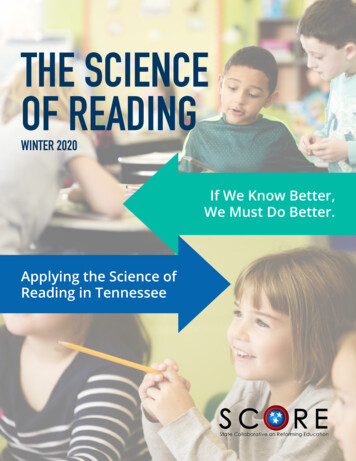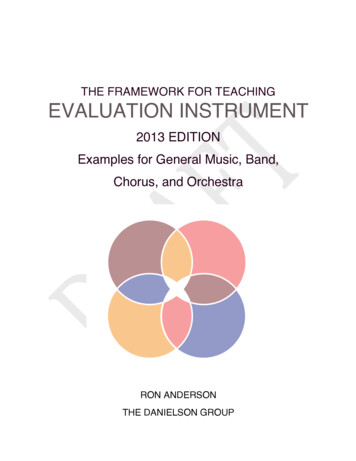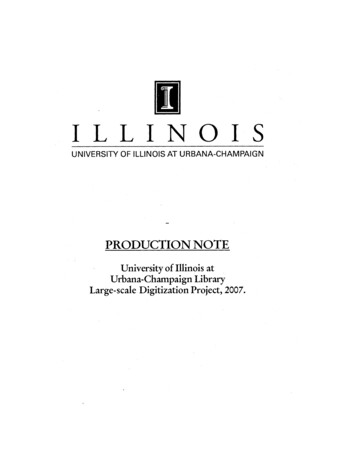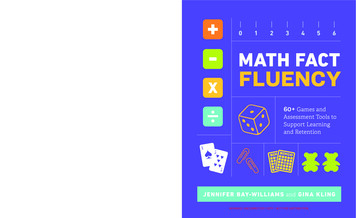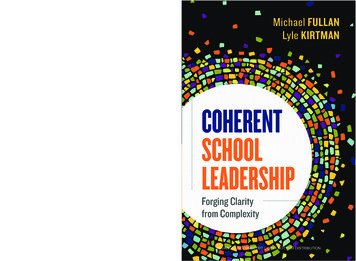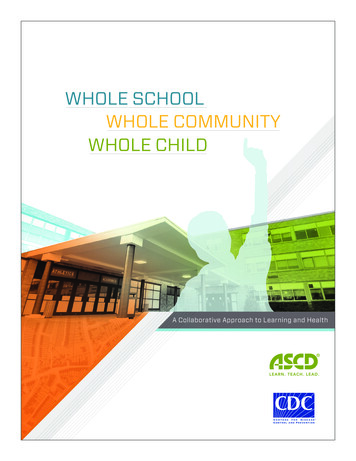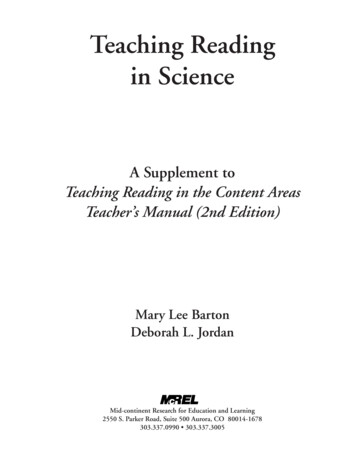
Transcription
Teaching Readingin ScienceA Supplement toTeaching Reading in the Content AreasTeacher’s Manual (2nd Edition)Mary Lee BartonDeborah L. JordanMid-continent Research for Education and Learning2550 S. Parker Road, Suite 500 Aurora, CO 80014-1678303.337.0990 303.337.3005
Teaching Reading in ScienceA Supplement to Teaching Reading in the Content Areas: If Not Me, Then Who?2nd EditionMARY LEE BARTONDEBORAH L. JORDANCopyright 2001 McREL (Mid-continent Research for Education and Learning), Aurora,Colorado. All rights reserved. No part of this publication may be reproduced or transmittedin any form or by any means, electronic or mechanical, including photocopy, recording, orany information storage and retrieval system, without permission in writing from McREL.This publication is based on work sponsored wholly, or in part, by the U.S. Department ofEducation National Eisenhower Mathematics and Science Programs, Office of EducationalResearch and Improvement (OERI), under Grant Number R319A000004B. The content of thispublication does not necessarily reflect the views of OERI or the Department of Education orany other agency of the U.S. Government.To purchase additional copies of this book, contactAssociation for Supervision and Curriculum Development1703 N. Beauregard St. Alexandria, VA. 22311-1714 USATelephone: 800-933-2723 or 703-578-9600 Fax: 703-575-5400Web site: http://www.ascd.org E-mail: member@ascd.orgDiscounts for bulk purchases are available.ASCD Stock number #302269ISBN-13: 978-1-893476-03-5ISBN-10: 1-893476-03-0Prices: ASCD member, 20.95; nonmember, 22.95
Table of ContentsAcknowledgments . iiRationale . iiiSection 1: Three Interactive Elements of Reading . 1The Role of the Reader . 3The Role of Climate . 8The Role of Text Features . 14Text Features: Vocabulary . 14Text Features: Text Style . 19Section 2: Strategic Processing . 29Section 3: Strategic Teaching . 39Section 4: Six Assumptions About Learning . 45Section 5: Reading Strategies . 49Vocabulary Development . 50Informational Text . 72Reflection Strategies . 109Bibliography . 127About the Authors . 131Workshops Available . 132i
AcknowledgmentsA number of people contributed to the production of this document. In particular, theauthors would like to acknowledge Mid-continent Research for Education and Learningstaff, specifically Alice Krueger, who constructed the secondary level examples inSection 5; Linda Brannan and Terry Young, who helped with the literature search;Norma Brown, who oversaw copyright permissions; quality assurance reviewers JohnSutton, Clare Heidema, Elaine DeBassige D’Amato, Barb Gaddy, Vicki LaRock, JaneDoty, and Dan Seger; editor Vicki Urquhart; and Leah Dixon and Molly Drew, whoperformed the desktop publishing portion of this project. The authors would also like toacknowledge outside reviewers Marcia Daab, Nancy Kellogg, and Emily CoBabe.ii
RationaleAsk students to take out their science textbooks, and what response do you typicallyget? Groans? Sighs? Comments that are less than enthusiastic?This reaction is understandable. For many students, reading science is like reading aforeign language. A high school chemistry text can contain some 3,000 new vocabularyterms — far more than are taught in most foreign language classes (Holliday, 1991). Inaddition, it’s not unusual for science textbooks to have a readability level one or twoyears above the grade level in which they are used. Finally, many textbooks aren’tparticularly user friendly. This is often the case when they are written by content-areaexperts without the assistance of professional writers or experienced practitioners whocould help ensure that ideas were communicated clearly.Science teachers, themselves, appear to feel somewhat ambivalent about textbookusage. Although teachers agree that students need to be able to read science, 28 percentof elementary teachers surveyed nationwide in 1998 reported using textbooks only as areference source; 33 percent reported rarely or never using textbooks (Tolman, Hardy, &Sudweeks, 1998).Why do teachers feel so ambivalent about textbooks? One possible reason is students’inability to read these texts. Another is that the content of science textbooks can becomeoutdated more quickly than, say, an American literature textbook, rendering thesebooks less useful as the years go by. A third reason cited by critics of science textbooks isthat textbooks emphasize product rather than process (Donahue, 2000). In an inquirybased approach to learning that accompanied the post-Sputnik era of the 1960s, scienceeducation has focused largely on doing science rather than reading science.Many educators contend that when students do science, they are more engaged inlearning than when they read science text. When students actively participate in science,they are involved in collaboration, exploration, and problem solving. Hands-on scienceactivities give students opportunities to wrestle with science problems; work together to generate and test hypotheses; and analyze data, draw conclusions, and write about their findings.iii
In fact, reading science text and textbooks requires the same critical thinking, analysis,and active engagement as performing hands-on science activities. Science and readinghave many process skills in common. As Armbruster (1993) contends, “The same skillsthat make good scientists also make good readers: engaging prior knowledge, forminghypotheses, establishing plans, evaluating understanding, determining the relativeimportance of information, describing patterns, comparing and contrasting, makinginferences, drawing conclusions, generalizing, evaluating sources, and so on” (p. 347).In this supplement, as in the Teaching Reading in the Content Areas (TRCA) Teacher’sManual, we present the latest research on reading and learning in science. We alsoinclude suggestions on how to help students confront the unique challenges ofconstructing meaning from science textbooks and on how to embed explicit sciencereading instruction within the natural context of science instruction in the classroom.Throughout this supplement, you will find references to sections or pages of the TRCATeacher’s Manual that provide a more thorough discussion of a topic or another exampleof a reading strategy.In Section 5 of this supplement, you will find references to the five phases of learning —engage, explore, explain, elaborate, and evaluate — which are common components ofscience instructional models. Science teachers are encouraged to use the “5E” approachor instructional models that share these components to build students’ in-depthunderstanding of science concepts and strengthen their thinking skills (see Section 3,pp. 39–44 for more about the five phases of learning). Reading science texts and othermaterials is an important part of this process. For students to gain understanding,teachers need to use a variety of strategies, including those that involve manipulative,interactive, and physical materials, to address science content in depth and avoidfocusing on isolated or disconnected facts.iv
Section 1NotesThree Interactive Elements of ReadingThree Interactive Elements of s Santa, Havens, and Harrison (1996) state it well: “Moststudents arrive at the science teacher’s classroom knowing how toread, but few understand how to use reading for learning sciencecontent” (p. 166). One explanation for this disparity is that studentsmost often learn the reading process using narrative text. Theyhaven’t been taught that reading science requires different readingand thinking skills than reading fiction. Certainly, informational text— and science text, in particular — presents unique challenges tonovice readers. Thus, one of the first steps for teachers is to helpstudents understand that reading science text requires them to usedifferent skills than they may have used in the past.In addition to the general reading skills needed to comprehendnarrative text, readers of science text also must be able to apply thefollowing knowledge and skills: Understand specialized vocabulary terms and phrases that areunique to science. Understand vocabulary terms and phrases that have differentmeanings when used in science. Interpret scientific symbols and diagrams.1
Notes Recognize and understand organizational patterns common toscience texts. Make sense of text using text structure and page layout thatmay not be user friendly. Infer implied sequences and recognize cause-and-effectrelationships. Infer main ideas and draw conclusions that may not beexplicitly stated. Use inductive and deductive reasoning skills.These skills are discussed in more detail in the sections that follow,which also include suggestions for planning instruction that will helpstudents become more effective consumers of science readingmaterial. As in the TRCA Teacher’s Manual, this supplement discussesteaching reading in science in terms of three interactive elements thataffect comprehension: the reader, the climate, and text features.2
The Role of the ReaderNotesThree Interactive Elements of ReadingReaderClimateTextFeaturesThings to Think About1. How do students’ experiences and prior knowledge ofscience affect their learning?2. How can teachers help students recognize and change anymisconceptions they have about science?3. How can teachers motivate students to learn and practicereading strategies?Prior KnowledgeFor students to make sense of what they read, they need to be able tograsp and make sense of new information in light of what theyalready know. When readers activate and use their prior knowledge,they make the necessary connections between what they know andnew information. Teachers should help students recognize theimportant role that prior knowledge plays and teach them to use thatknowledge when learning science through reading.Teachers can show students how to activate prior knowledge bydemonstrating basic pre-reading techniques such as brainstorming ideas that a topic brings to mind; previewing a passage, noting headings and bold print; and constructing a graphic organizer, web, or outline from passageheadings for use in note taking.3
NotesTeachers also need to ensure that their students have the priorknowledge and experience they need to make these connections.Discovering what students already know about a topic helps teachersdesign instruction around the missing knowledge. A number ofstrategies can help teachers determine what students know beforethey begin studying a new topic: Semantic Mapping (p. 61) Word Sort (p. 69) Anticipation Guide (p. 72) Directed Reading/Thinking Activity (p. 76) K-W-L (p. 91) Problematic Situation (p. 99) Learning Log (p. 114)Prior knowledge must not only be adequate for learning to occur, italso must be accurate. Unfortunately, sometimes students come totheir science classes with a number of misconceptions about topicsthey will be studying. Helping students confront and resolve theirmisconceptions requires concentrated effort on the part of teachersand students. The strategies listed above can help teachers identifystudents’ misconceptions.Another strategy that addresses students’ misconceptions is theextended anticipation guide (Duffelmeyer & Baum, 1992). Thisstrategy requires learners to identify their beliefs prior to reading andto justify these ideas — or revise them — when they read informationin the text that supports or contradicts their understanding. (See pp.72–75 in this supplement for instructions on using this strategy inthe classroom.) Because letting go of misconceptions is so difficult,this issue is extensively addressed in Section 3, “Strategic Teaching.”4
Mental DispositionNotesExemplary science educators know that students’ attitudes aboutreading and learning science affect their achievement. Of particularconcern, then, are reports that students’ motivation to learn wanesover time. For example, Holloway (1999) notes that “intrinsicmotivation for literacy and other academic subjects declines inmiddle school” (p. 80). What can teachers do to increase students’motivation to learn from reading science text?In addition to connecting reading assignments to students’ realworld experiences, teachers need to show students that becomingeffective consumers of science text has value. Students need to seefirsthand that practicing the right reading strategies will improvetheir achievement.This is especially true of struggling readers. Some of these studentsalso have a poor attitude toward reading and often don’t see theconnection between the effort they put forth to read and completetheir assignments and the grades they earn in class. Marzano,Pickering, and Pollock (2001) cite a set of studies demonstrating thatsimply showing students that added effort improves theirachievement actually increases students’ achievement. The authorsnote that since “students might not be aware of the importance ofbelieving in effort,” teachers should “explicitly teach and exemplifythe connection between effort and achievement” (p. 51).Instructional ImplicationsTo demonstrate to students how their effort affects their achievement,Marzano et al. (2001) suggest that students periodically assess theirlevel of effort on assignments and track the impact of their effort onthe grades they earn. Teachers can give students a set of effort andachievement rubrics (see Exhibit 1 on p. 6), which students canuse to assess their effort and achievement. In addition, a chart (seeExhibit 2 on p. 7) can be provided so students can record and tracktheir progress.5
NotesWhen students observe the impact that their effort and attitude haveon their progress, they begin to see the value of applying readingstrategies to improve their comprehension and learning. They alsogain a sense of control over their learning — a crucial step inassuming more responsibility for their own learning.Exhibit 1. Effort and Achievement RubricsEffort and Achievement Rubrics for ScienceScale: 4 excellent; 3 good;2 needs improvement; 1 unacceptableEffort Rubric4I worked on my science assignment until it was completed.I pushed myself to continue working on the task evenwhen difficulties arose, when a solution was notimmediately evident, or when I had trouble understandingwhat an author was saying. I used obstacles that arose asopportunities to strengthen my understanding and skillsbeyond the minimum required to complete the assignment.3I worked on my science assignment until it was completed.I pushed myself to continue working on the task evenwhen difficulties arose, when a solution was notimmediately apparent, or when I had troubleunderstanding what an author was saying.2I put some effort into my science assignment, but I stoppedworking when difficulties arose, when a solution was notimmediately evident, or when I had trouble understandingwhat an author was saying.1I put very little effort into my science assignment.Achievement Rubric64I exceeded the objectives of the assignment.3I met the objectives of the assignment.2I met a few of the objectives of the assignment, but didn’tmeet others.1I did not meet the objectives of the assignment.
Exhibit 2. Effort and Achievement ChartStudentJon StarekAssignmentNotesEffort AchievementRubricRubricMonday, Sept. 21Study and describe partsof three differentflowering plants. Read textabout plant parts and findparts on actual plants tocomplete worksheet.44Wed., Sept. 23Homework: Read the article"How Plants Grow."33Thurs, Sept. 24Write a two-page narrativeon key points made in thearticle and how thesereinforce or conflict withwhat I thought I knewabout how plants grow.33Fri., Sept. 25Read text pages onexperimental design anddesign experiment ongermination rate of plants.337
NotesThe Role of ClimateThree Interactive Elements of ReadingReaderClimateTextFeaturesThings to Think About1. How does climate affect students’ attitude toward learningscience?2. What do effective science teachers do to create a classroomclimate that is conducive to learning?A fifth grade teacher always begins the year by asking her class thissimple question: “What is science?” The varied responses studentsgive usually cover three basic themes:“Science is fun. It’s doing experiments and watching butterflies emerge fromtheir chrysalises.”“Science is reading boring textbooks. I hate it.”“Science is watching movies or videos.”What shapes students’ attitudes about science? Certainly, students’attitudes are deeply affected by the climate in which they learn.Teachers’ beliefs, attitudes, and values help to create the climate inwhich children develop their own feelings about subject matter. Infact, as early as the fifth grade, students have developed definiteattitudes about science. Sadly, many students graduate from highschool despising science, considering it boring and too difficult. Asthe authors of Science for All Americans (Rutherford & Ahlgren, 1990)note, “They see science only as an academic activity, not as a way ofunderstanding the world in which they live” (p. 186).Given the effect that attitude has on learning, it’s essential thatscience teachers create a positive classroom climate. The term climate8
refers not only to the affective dimensions discussed in the TRCANotesTeacher’s Manual, but also to physical dimensions. As ProgramStandard D of the National Science Education Standards (NationalResearch Council [NRC], 1996) asserts, “The K–12 science programmust give students access to appropriate and sufficient resources,including quality teachers, time, materials, and equipment, adequateand safe space, and the community” (p. 218).The climate in today’s exemplary science classrooms is grounded inthe high standards and vision described in the National ScienceEducation Standards (NRC, 1996): “All students, regardless of age, sex,cultural or ethnic background, disabilities, aspirations, or interest andmotivation in science, should have the opportunity to attain highlevels of scientific literacy” (p. 20). Science instruction is no longerviewed solely as preparation for college-bound students. Today’sscience students come from all walks of life and have a wide range ofbackgrounds and experiences.What constitutes an effective learning environment? According to theNRC (2000), an effective learning environment is characterized byfour dimensions: Learner centered: Respecting and understanding students’prior experiences and understandings and using them to buildnew understandings. Knowledge centered: Helping students focus on the “big”ideas and “develop well-organized bodies of knowledge andorganize that knowledge so that it supports planning andstrategic thinking” (p. 122). Assessment centered: Helping students learn to monitor andregulate their own learning, to think critically, and to receiveinstruction that is informed and supported. Community centered: Requiring students to “articulate theirideas, challenge the ideas of others, and negotiate deepermeaning along with other learners” (p. 122).9
NotesInstructional ImplicationsWhat can teachers do to ensure that their classrooms incorporatethese elements?Learner centeredTo ensure that the classroom environment is learner-centered,teachers should consider the individual needs of their students. Aseach lesson is planned, it’s important to consider the extent to whicheach student has the background knowledge needed to understandthe concepts that will be taught. This step may point to the need tocreate learning experiences that provide students with additionalinformation about particular concepts prior to giving them readingassignments.Engaging students in concrete learning activities can help preparethem to learn more abstract ideas. These activities can introducestudents to concepts, which will then be reinforced, confirmed, orenriched through reading. Consider using an anticipation guide,DR/TA, K-W-L, problematic situation, graphic organizer, PLAN, orother pre-reading activities to activate, build, and reinforcebackground knowledge students need in order to make connectionswhile reading. (See Section 5, pp. 49–125 of this supplement for thesepre-reading strategies.)Knowledge centeredIn a knowledge-centered learning environment, students are offereda variety of opportunities to learn about the discipline of science.Teachers help students recognize the “big ideas” in science anddifferentiate between main ideas and supporting material in theirscience textbooks. They also ask students to use this knowledge tomake connections among these ideas and apply them in newsituations. As discussed in the next section, “The Role of TextFeatures,” science text can be difficult for even experienced readers.Teachers should reread text material that they plan to assign to see if10
main ideas are expressed clearly and if the relationships among ideasNotesare evident.To get the most out of their science textbooks, students mustunderstand how the information is organized and how the conceptspresented relate to one another (Misulis, 1997). Teachers can providestudents with graphic organizers that will help them recognize andunderstand relationships among the ideas they read in their texts. Inaddition, teachers should incorporate questioning and reflectionstrategies that focus students’ attention on understanding knowledgederived from the text and on making connections between what theyhave observed and what they have read. A number of strategies,including reciprocal teaching, learning logs, and question-answerrelationships, are designed to clarify students’ understanding of whatis presented in class and in their textbooks. (See Section 5 of thissupplement for these strategies.)Assessment centeredAssessment-centered classrooms encourage students to monitor andregulate their learning in response to feedback from self-assessmentand teachers’ assessments. Learning to monitor and regulate theirown learning is a skill that can benefit students throughout theireducation — indeed, throughout their lives.There are many ways to teach and reinforce students’ self-assessmentskills. For example, teachers can encourage students to assess theirown learning by collecting data, comparing results with others, andapplying what they have learned. As students become adept atmonitoring their learning, they will be better equipped to assess theirunderstanding of text and to monitor and regulate theirunderstanding as they read.Teachers can encourage the art of self-evaluation in a number ofways. First, they can model for students how they monitor theirunderstanding when reading and learning new information. Inaddition, teachers can ask students to reflect on their learning using11
Noteswriting-to-learn activities or leading discussions about what learningstrategies are most effective when comprehension problems arise.Finally, teachers should explain — and model — that assessmentactivities offer learners and their teachers valuable feedback. Forexample, instead of simply grading and returning students’ labreports, teachers might note areas that need further work and requirestudents to use these comments to make any needed revisions.Thoughtful educators also use assessment results to revise theirinstructional approaches. In this way, they treat assessment not as aproduct, but rather as part of an ongoing process that supportslearning and informs instruction.Community centeredA community-centered classroom offers students a safe environmentin which they can learn from their mistakes and from one another.One way to begin to create this kind of environment is to givestudents extra credit for sharing their confusion and questions aboutwhat they have read, a strategy suggested by Schoenbach, Greenleaf,Cziko, and Hurwitz (1999). The authors also suggest telling studentsthat the more explicit they are about where in a text they got lost orwhy they think something is difficult for them to understand, themore credit they will receive. The benefits of this strategy are many.For one, talking with others can help students more specificallyidentify the questions they have or the topics they find confusing.Second, classroom dialogue and conversation help develop a sense ofcommunity among students and between students and the teacher.Another strategy suggested by Schoenbach et al. (1999) is to invitestudents to bring in reading materials that will “stump” the teacherso the teacher can model “think-alouds,” which lets students knowthat teachers, too, often have to use strategies to understand whatthey are reading.In summary, the characteristics of science learning present a uniquechallenge — and opportunity — for science teachers as they design12
the classroom learning environment. By identifying individualNotesstudents’ needs, helping students to focus on “big ideas,” usingassessment as a springboard for learning, and creating a communityin which students learn and deepen their understanding together,teachers can help ensure that students leave their classes with apositive view of the benefits of learning science.13
Section 5NotesReading StrategiesStrategies for the Three Phases ofCognitive ProcessingVocabulary 9599101105106107xxxxxxxxxxxPage NumberS-1 Concept Definition MappingS-2 Frayer ModelS-3 Semantic Feature AnalysisS-4 Semantic MappingS-5 Student VOC StrategyS-6 Word SortxInformational TextS-7 Anticipation Guide/Revised Extended Anticipation GuideS-8 Directed Reading/Thinking Activity (DR/TA)S-9 Graphic OrganizerS-10 Group SummarizingS-11 What I Know; Want to Learn; Learned (K-W-L)S-12 Pairs ReadS-13 Predict; Locate; Add; Note (PLAN)S-14 Problematic SituationS-15 Proposition/Support OutlineS-16 Reciprocal TeachingS-17 Survey, Question, Read, Recite, Review (SQ3R)S-18 Think-AloudxxxxxxxxxxxxxxxxReflection Strategies (Questioning; Writing; Discussing)S-19 Creative DebateS-20 Discussion WebS-21 Learning LogS-22 Question-Answer Relationship (QAR)S-23 Questioning the Author (QtA)S-24 Role/Audience/Format/Topic (RAFT)S-25 Scored Discussion109111114117120122124xxxxxxxxxx49
NotesVocabulary DevelopmentS-3. Semantic Feature AnalysisPreactiveInteractiveReflectiveWhat is it?Semantic feature analysis (Baldwin, Ford, & Readence, 1981; Johnson& Pearson, 1984) helps students discern a term’s meaning bycomparing its features to those of other terms that fall into the samecategory. When students have completed a semantic feature matrix,they have a visual reminder of how certain terms are alike ordifferent.How could it be used in science instruction?This strategy is very effective when examining discriminatingfeatures (e.g., categorizing vertebrates, invertebrates, types of rocks,powders, and crystals). This strategy can be used to engage studentthinking, as a way to collect data while students explore similaritiesand differences, or as a way to quickly evaluate students’ knowledge.How to use it:1. Select a general category of study.2. Create a matrix. Along the left side, list key terms in the chosencategory. Across the top of the matrix, write features that thesewords might share.3. Ask students to then use an “X” to indicate if the feature appliesto the word or write in specifics about the features.4. Encourage students to explain the rationale behind their choices.5. As the unit progresses and understanding of each term orconcept deepens, the teacher or students can add terms andfeatures to the matrix.For further discussion of this strategy, see the TRCA Teacher’s Manual,pp. 79–81.58
NotesVocabulary DevelopmentSemantic Feature Analysis GridFeaturesCategory:Termsirprodfor uceyo mun blrmwabloldconebockbaTermsFeatureseddedCategory: Vertebratesfishamphibianreptilebirdmammal59
NotesVocabulary sometimes sometimes yurresrsCategory: RocksXXXXmarbleXXquartziteXXXXmainlyXbytransferdte 1mm1–108radiosradiationmicrowaves1 m–30 cm108–1012microwavedetectorsradiationwade
books less useful as the years go by. A third reason cited by critics of science textbooks is that textbooks emphasize product rather than process (Donahue, 2000). In an inquiry-based approach to learning that accompanied the post-Sputnik era of the 1960s, science education has focused largely on doing science rather than reading science.
